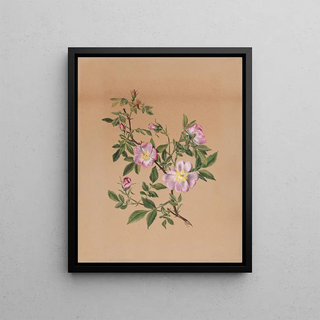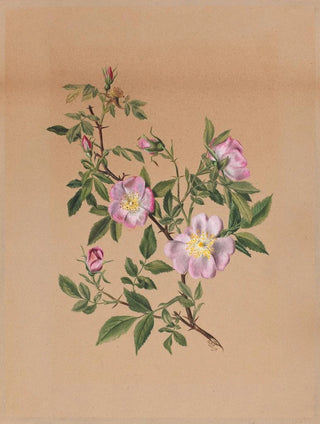Art print | Mauve pink hibiscus moscheutos - Mary Vaux Walcott


View from behind

Frame (optional)
In the vast panorama of art history, some works stand out for their ability to capture the very essence of nature. "Art print Rose mauve Hibiscus moscheutos - Mary Vaux Walcott" is one such creation. This piece, imbued with delicacy and precision, invites us to delve into a floral universe where every detail is carefully observed. The depiction of this flower, emblematic of North American wetlands, evokes not only the beauty of flora but also a deep respect for the environment. The finesse of the strokes and the subtle harmony of colors transport us to a lush garden, where the hibiscus stands majestically, like a visual poem celebrating nature.
Style and uniqueness of the work
Mary Vaux Walcott's style is characterized by a naturalist approach, blending scientific observation with artistic sensitivity. In "Art print Rose mauve Hibiscus moscheutos," the artist manages to marry rigor and aesthetics, creating a piece that transcends mere visual recording. Each petal seems to vibrate under the light, each shade of pink and mauve is rendered with such precision that one could almost feel the softness of the flower. The use of watercolor allows Walcott to play with transparency and luminosity, giving life to delicate textures that seem almost tangible. This work does not merely depict a flower; it evokes a feeling, an atmosphere, a deep connection with nature. It is this singularity that makes "Art print Rose mauve Hibiscus moscheutos" an essential piece for art and botany enthusiasts.
The artist and her influence
Mary Vaux Walcott, born in the early 20th century, is an iconic figure in American floral art. Her work is part of a tradition where art and science meet, a process that allows her to stand out in the world of botanical art. Passionate about nature, Walcott dedicated a large part of her life to studying plants, which nourished her art. She was one of the first women to be recognized in a field often dominated by men, and her influence still endures today. Through her works, she has

Matte finish

View from behind

Frame (optional)
In the vast panorama of art history, some works stand out for their ability to capture the very essence of nature. "Art print Rose mauve Hibiscus moscheutos - Mary Vaux Walcott" is one such creation. This piece, imbued with delicacy and precision, invites us to delve into a floral universe where every detail is carefully observed. The depiction of this flower, emblematic of North American wetlands, evokes not only the beauty of flora but also a deep respect for the environment. The finesse of the strokes and the subtle harmony of colors transport us to a lush garden, where the hibiscus stands majestically, like a visual poem celebrating nature.
Style and uniqueness of the work
Mary Vaux Walcott's style is characterized by a naturalist approach, blending scientific observation with artistic sensitivity. In "Art print Rose mauve Hibiscus moscheutos," the artist manages to marry rigor and aesthetics, creating a piece that transcends mere visual recording. Each petal seems to vibrate under the light, each shade of pink and mauve is rendered with such precision that one could almost feel the softness of the flower. The use of watercolor allows Walcott to play with transparency and luminosity, giving life to delicate textures that seem almost tangible. This work does not merely depict a flower; it evokes a feeling, an atmosphere, a deep connection with nature. It is this singularity that makes "Art print Rose mauve Hibiscus moscheutos" an essential piece for art and botany enthusiasts.
The artist and her influence
Mary Vaux Walcott, born in the early 20th century, is an iconic figure in American floral art. Her work is part of a tradition where art and science meet, a process that allows her to stand out in the world of botanical art. Passionate about nature, Walcott dedicated a large part of her life to studying plants, which nourished her art. She was one of the first women to be recognized in a field often dominated by men, and her influence still endures today. Through her works, she has






